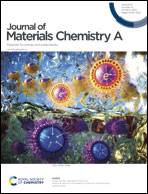Weak Pb–O of confined [Pb–O4] in pyramidal sillenite-type Bi12PbO20 for enhanced electrochemical ozone production†
Abstract
An alternative method for producing ozone, electrochemical ozone production (EOP) is a major area of interest in the field of in situ sterilization and disinfection. However, commercial lead dioxide as a traditional anodic electrocatalyst is highly toxic and has low durability, and exploring anodic electrocatalysts with lower lead content and performance loss is challenging. Herein, a series of pyramidal sillenite-type Bi12PbO20 materials were designed and fabricated with a hydrothermal method in which Pb was introduced to Bi2O3 frameworks. The product, Bi12PbO20-3, exhibited remarkable EOP performance, with faradaic efficiency of 15.1% at 50 mA cm−2 in a neutral solution, which was almost 1.5 times that of commercial β-PbO2. Computational simulations further demonstrated that the confined [Pb–O4] fragment was confined in the Bi–O bonding environment of Bi12PbO20, the low oxygen vacancy formation energy resulted from the weak Pb–O interaction and remarkably enhanced EOP activity. Such a local confined environment plays a vital role in suppressing Pb loss, thereby accounting for the robust EOP stability. Additionally, the significant performance of the membrane electrode assembly system in the electrochemical degradation of antibiotics and pesticides implied the potential environmental application capabilities of Bi12PbO20.
![Graphical abstract: Weak Pb–O of confined [Pb–O4] in pyramidal sillenite-type Bi12PbO20 for enhanced electrochemical ozone production](/en/Image/Get?imageInfo.ImageType=GA&imageInfo.ImageIdentifier.ManuscriptID=D1TA10701A&imageInfo.ImageIdentifier.Year=2022)


 Please wait while we load your content...
Please wait while we load your content...